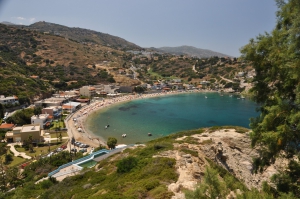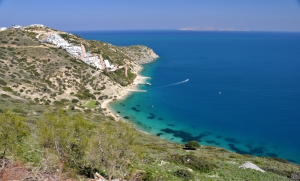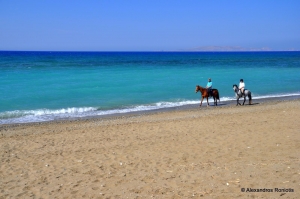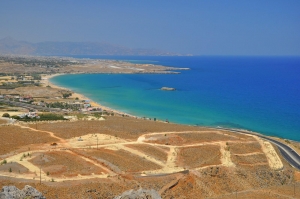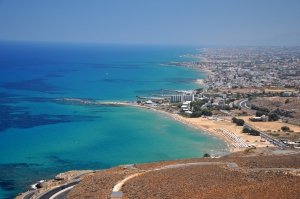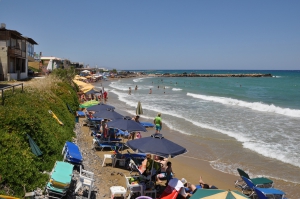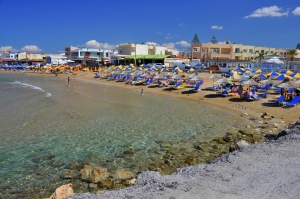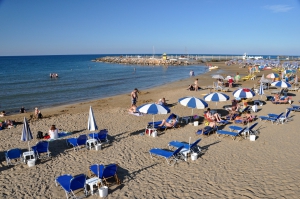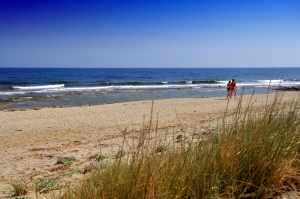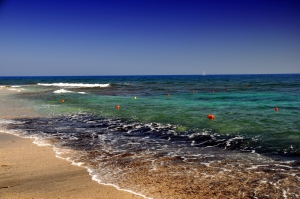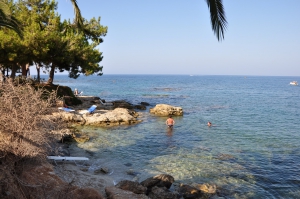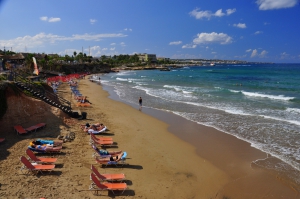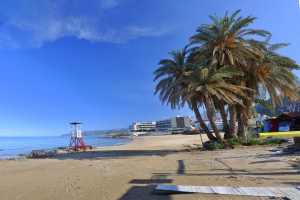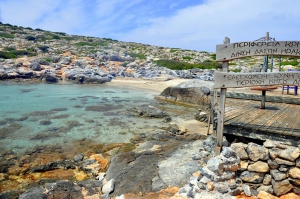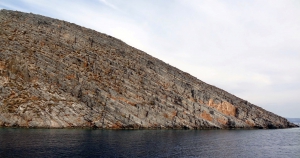Ligaria is located 21km north west of Heraklion and 1km east of Agia Pelagia. The Bay of Ligaria is closed and well protected from the winds blowing in the region. Nearby there are the ruins of the old monastery of Panagia Ligariani, where many monks lived in the past. The region gets its name from the monastery, which in turn gets its name from the beautiful plant “osier” (ligaria in Greek), with the flexible stems and the beautiful flowers, which used to abound in the area.
Madé (or Madés) is a small coastal village located near Ligaria, 20km northwest of Heraklion and 1.5km east of Ligaria beach. It is located near the northernmost edge of the Gulf of Heraklion, which called Cape Bourouni of Rogdia. To get this far from Heraklion, drive in the highway to Chania and take the exit of Ligaria. Just after 1.5km you will see a sign for Madé.
The bay of Fraskia of Panagia (i.e. Virgin Mary) is located 24km northwest of Heraklion, on the western side of the Gulf of Heraklion. It is located at the exit of a small valley next to the current private settlement of Theseus. The name Fraskia is taken after the Cretan word fraski, that was a type of jar that was used by Cretans as beehive. Indeed, the area is full of thyme, herbs and shrubs, which are ideal for producing honey.
Paliokastro (or Paleokastro) is located 14km west of Heraklion, on the western shores of the Bay of Heraklion. It is a picturesque beach with pebbles, shaped in the exit of a green valley which is crossed by the torrents descending from the village Rogdia. Paliokastro cove is well protected on both sides by tall cliffs and faces east.
Pantanassa is located 12km west of Heraklion and takes its name after the homonym monastery, dedicated to Virgin Mary. The beach is next to the port of Pantanassa, which was built a few years ago. Before the port, Pantanassa was a fantastic beach, hidden by a small pine forest and with crystal clear waters. Now, the port has “cut” the beach in half and Pantanasa has lost its old charm.
Linoperamata (or Ellinoperamata) is a long sandy beach, that is located 8km west of Heraklion, west of Almiros river. This is actually the west part of the 7km long beach starting at Linoperamata and ending at Pancretan Stadium, 1km west of Heraklion.
Ammoudara is a long beach which starts 1km west of the center of Heraklion and reaches the mouth of the river Almyros, 7km on the west. Ammoudara is today a suburb of Heraklion, with thousands of visitors every year, mainly because of the vast beach.
On the vast bay, there are two settlements, Karteros and Amnissos. The area has grown so much that the two villages are now united. The main reason for the rapid development of the area is the small distance from Heraklion and the vast beach with the fine golden sand.
Vathianos River empties in the area, but it gets dry on the summer. The area has several adjacent coves with gold sand and shallow waters. Because the beach front is facing north, waves are quite common. That's why in some places you will see several small piers, breaking the waves.
Kokkini Hani is located 15km west of Heraklion, west of Vathianos Kambos. The area is a very well-developed resort, surrounded by the many crops cultivated in the plain of the area. The name of the site means “Kokkinis’s Inn” and is taken after an inn that operated here in the early 1900s, by someone called Kokkinis.
Gournes is a tourist resort located 16km east of Heraklion, between Kokkini Hani and Gouves. The area of Gournes is located in a large fertile plain with many vegetable crops and olive groves. Gournes was in the past a separate village but the rapid development of the region has made it one part of the united beachfront, which now starts in Vathianos Kambos and ends after 23 kilometers, in Malia. Gournes are situated on the 3rd kilometer of this front.
Kato Gouves (or simply Gouves) is a popular holiday resort located 18km east of Heraklion, in the foothills of Mount Ederi. In the past, the valley of Kato Gouves was cultivated by the residents of the village of Ano Gouves with vegetables, olives, and cereals.
Analipsi later was occupied by the the shepherds of Saint George village, in Lasithi Plateau, where the winter is very cold. Thus, they moved their cattle here in winter. Today, the lucky descendants of the shepherds have large properties in the area, with hotels, shops, restaurants and all sorts of tourist facilities.
The peaceful resort of Anisaras is located 21km east of Heraklion, west of Cape Sarandaris. The area is now full with big hotels, which offer primarily all-inclusive services. In front of the hotels, there are small sandy beaches with rocky seabed. All beaches are well-organized with umbrellas and sun beds, which are offered for free to the customers of the hotels.
The Coves of Hersonissos are located 27km east of Heraklion, starting from Cape Sarandaris and continuing to the east till the harbour of Hersonissos. They are really beautiful beaches with calm waters, since Cape Sarandaris protects them from the northwest winds.
Hersonissos is a very busy, touristic town located 28km east of Heraklion. 2km east of the Hersonissos port, you'll find several nice coves, that constitute the complex of east Hersonisos beaches.
Stalis (or Stalida) is located 30km east of Heraklion, in the midway of Malia and Hersonissos. From a small seaside village set up by the residents of Mohos, Stalis is today a popular tourist resort, which is united with Malia town. The only difference with Malia is that Stalis attracts mainly families and things here are more peaceful.
The beach of Malia is the eastern part of the vast beach (6km length) starting from Stalis. It is a wide beach with fine sand and shallow waters. It is so crowded that there is no space between the sunbeds to fit a pin! Here you can find whatever comfort you ask.
Dia is a small uninhabited island located 12 miles north of Heraklion. During the summer, excursion boats run daily to Dia, where the visitor can admire the rugged landscape of the island and swim in the crystal clear waters. The place where the boats stop is called the port of St. George.










